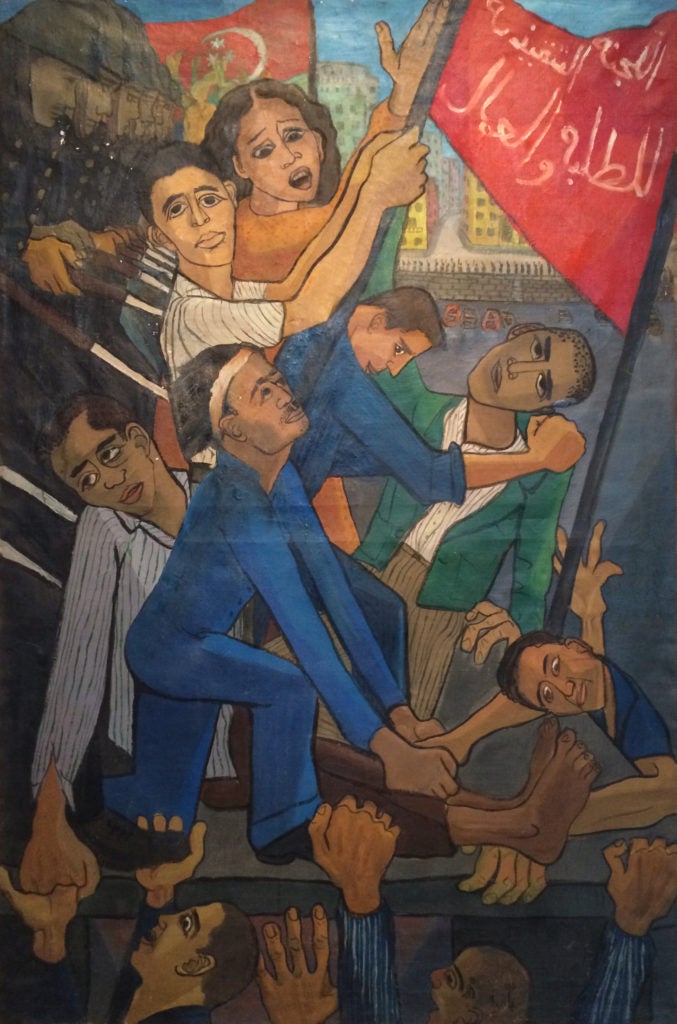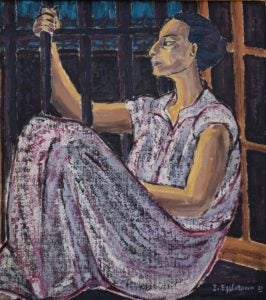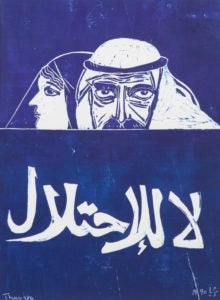Celebrating women artists of the Arab world whose works have documented important historical moments and rallied for social and political change.
By Sultan Sooud Al Qassemi

In February 1946, Egyptian students and laborers marched on Abbas Bridge connecting Old Cairo and Giza to protest the policies of Prime Minister Mahmoud Fahmy Nokrashy (1888-1948). The police pushed back by opening the movable bridge and “leaving many of [the protesters] to fall into the Nile or get trampled in the stampede.” The scene of huddled students dangling from the seams was captured by Egyptian artist Gazbia Sirry (b.1925) in her 1955 painting Abbas Bridge, now in the collection of the Museum of Modern Egyptian Art in Cairo.
In the first half of the 20th century, women artists globally, and across the Arab world—like Gazbia Sirry—were often relegated to a secondary role. The School of Fine Arts that opened in Cairo in 1908, for example, accepted only male students. It was over thirty years later, in 1939, that the Higher Institute of Fine Arts for Female Teachers opened as the first arts academy for women in the region. The 1930s also saw the establishment of annual Women’s (art) Salons in Egypt, although—as scholar Patrick Kane notes in Egyptian Art Institutions and Art Education from 1908 to 1951—they have not been well studied. Additionally, male artists across the region—unlike their female counterparts—were the recipients of overtly political and nationalist commissions by Arab governments, ranging from Mahmoud Mokhtar’s Renaissance of Egypt (sometimes called Egypt’s Awakening) unveiled in Cairo in 1928, to Jewad Selim’s Monument to Liberation in Baghdad, completed after the artist’s passing in 1961. Nevertheless, women artists, although omit-ted from state commissions, did actively take part in documenting major political and social events through their work.

Dreams of the Detainee, 1961, oil on canvas, 45 x 50 cm.
Collection of Barjeel Art Foundation, Sharjah. Image courtesy of Barjeel Art Foundation, Sharjah.
Perhaps no other artists exemplified political activism thought art more than Inji Eflatoun (1924-1989), who used her paintbrush to depict historic cases of British injustice towards Egyptians, including the notorious Denshway massacre that took place following an altercation between Egyptian peasants and British soldiers. In somber black and white ink, Eflatoun depicts a scene from the massacre of a peasant being hung under the watchful eyes of British troops. She would go on to spend more than four years in jail for her political activism, producing dozens of works that captured the solitude and desperation of her fellow female inmates. At the height of Gamal Abdel Nasser’s ambitious Aswan Dam project, a number of women artists including Effat Nagi, Tahia Halim, Menhat Helmy, and Gazbia Sirry documented the round-the-clock construction, as well as the “resettlement” of tens of thousands of Nubians who were displaced by the project.
Syrian women artists also depicted major social and political moments in regional history. Lebanese-born, Syrian-naturalized artist Derrieh Fakhoury (1930-2015), wife of fellow artist Mahmoud Hammad, in 1963 painted Hunger, a work that was shown in the Autumn Salon in Damascus of the same year. The work depicts a mother and child who endured harsh circumstances surrounding a severe drought that extended from 1958 to 1961. In 1958, when Egypt and Syria forged a political union, Shukri al-Quwatli (1891–1967), the first president of an independent Syria handed over power to Gamal Abdel Nasser and stepped down from power, earning him the title of “First Arab Citizen.” A decade lat-er, one year after his passing, Hala Quwatly (b. 1938), the late politician’s daughter captured her father in that solemn moment in one of her paintings. The 1967 Nakba was also the subject of several works by female Syrian artists, including Asma Fayoumy who was born in Amman in 1943. Her 1968 painting Requiem for a City depicts the architectural contours of a town with several abstracted human faces huddled below, perhaps in sadness or in apprehension of the defeat and loss of the Golan Heights. In The Nation, paint-ed in 1978, Syrian artist Leila Nseir (b.1941) depicts a female martyr being carried by a group of mostly women surrounded by children as a representation of the killing of innocents and most likely a reflection on the Lebanese civil war that was raging nearby. Other Syrian artists such as Ikbal Karesly (1925-1969) depicted the torture of a civilian in 1959 and of a revolution in 1968, the first having never been exhibited in public due to fear of persecution.

War Painting (The Destruction of Iraq), 1991, oil on canvas, 70 x 50 cm.
Collection of Barjeel Art Foundation, Sharjah. Image courtesy of Barjeel Art Foundation, Sharjah.
The modern history of Iraq has been riddled with seismic events, many of which have been captured by women artists. Among them is Turkish born Fahrelnissa Zeid (1901–1991), who shortly after the July Revolution/Coup of 1958 painted La Balle (“The Bullet”) featuring a yellow ball against a black background, as though suspended in motion. That bullet, according to scholar and writer Adila Laïdi-Hanieh (an alum of the MAAS program at CCAS), is a depiction of the bullet that killed King Faisal II, whose death profoundly affected Zeid. Others, like Neziha Salim (1927–2008) captured the repercussions of the Iraq-Iran war in her 1982 painting Martyr’s Wife, in which a woman clad in a black abaya holds a circular red object reminiscent of a heart. Later artists like Afifa Aleiby (b.1953) would capture the destruction of her home country during and after the 1991 Gulf War in a series of paintings. Her War Painting (1991) illustrates a sculpture of a Sumerian king riddled with bullets.

No to the Invasion, 1990, lino-cut print, 40 x 30 cm.
Collection of Barjeel Art Foundation, Sharjah. Image courtesy of Barjeel Art Foundation, Sharjah.
Other parts of the Arab world also saw women artists depict political and social moments of the 20th century. Artist Safia Farhat (1924-2004) who, in 1966, became the first Tunisian—and also the first female—head of the Tunis Institute of Fine Arts, depicted scenes of laborers and fishermen as part of her socially-driven activism through art. Her 1952 portrait of Farhat Hached (1914–1952), founder of the General Union of Tunisian Workers and pro-independence leader for whom her husband worked, depicts Hached in a brown suit and red tie. Researcher Jessica Gerschultz writes in her recent book Decorative Arts of the Tunisian École (2019) that the portrait shows Hached in the same clothes he was wearing on the December 5, 1952—the day he was assassinated by a French extremist group. Kuwaiti artist Thuraya Al-Baqsami’s (b.1952) lino-cut print from the year 1990, depicts a resilient Kuwaiti man and woman wearing traditional clothes, with the Arabic phrase “No to the Occupation” rendered in white across the artwork. In response to the Iraq-Iran war, which raged between 1980 and 1988 and caused countless deaths, Bahraini artist Balqees Fakhro (b.1950) created a painting titled Face to Face (1986) as an artistic call for peace at an especially brutal moment during the eight-year conflict. It depicts a Sumerian king, who represents Iraq, and a Persian Achaemenid emperor, who represents Iran, sitting on the banks of the Shatt al-Arab River and extending their hands in friendship.
Palestinian artist Tamam Al-Akhal (b.1935), who was married to fellow artist Ismail Shammout, illustrated the Palestinian struggle in countless works. Khan Younis Massacre (1963) depicts the events of the 3rd of November 1956, when the towns of Khan Younis and Rafah were raided, leaving over 200 Palestinian men dead. Beirut-born, Palestinian artist Mona Hatoum (b.1952) largely worked on conceptual art, exploring themes such as violence and destruction. However, a number of her works relate to the region’s turbulent political history. Her bronze sculpture Infinity (1991-2001) depicts toy soldiers in an endless circle of violence to reflect the disposability of men to governments. In her 2009 sculpture Witness, Hatoum reproduces in porcelain a monument located in Beirut’s Martyr’s Square. Her reproduction keeps intact the wartime damage to the original statue—including bullet holes and a missing limb from one of the figures—rather than recreating a flawless, sanitized version of the monument.
As illustrated above, Arab women artists were—like their male counterparts—active throughout the 20th century, boldly depicting social and political moments in the histories of their countries. They have been integral participants and, in fact, often leaders in social and political activism, engaging in efforts to advance movements for independence and self-determination, to amend labor laws, and secure increased protection for the rights of women and children. While much of their work in and before the 1930s has gone unnoticed and undocumented, today these pioneering women artists are slowly but surely being more recognized for their immense contributions to the region’s artistic landscape. It is important for practitioners in the fields of art history, curation and museology to continue being ever more critical and mindful of their selection strategies and representation practices to ensure that the voices of trail-blazing artists previously omitted from historical record are acknowledged and documented.
Sultan Sooud Al Qassemi is an Emirati columnist and researcher on social, political, and cultural affairs in the Arab Gulf States. He is founder of the Barjeel Art Foundation, a prominent and publicly accessible art collection in the United Arab Emirates established in 2010 to contribute to the intellectual development of the art scene in the Arab region. Mr. Al Qassemi was a visiting adjunct instructor at CCAS during the fall 2019 semester.
This article originally appeared in the Spring 2020 issue of the CCAS Newsmagazine.